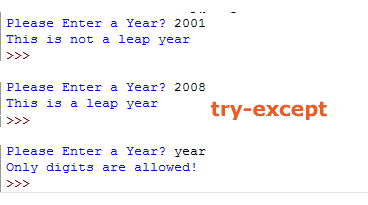

#Try except python code
We will write some code that has try, catch, and finally statements and all these statements also have try, catch, and finally statements under them. W3Schools offers free online tutorials, references and exercises in all the major languages of the web. This means that we can put try, catch, and finally statements under any try, catch, and finally statements. Lastly, the code under the outer finally statement is executed. To handle errors (also known as exceptions) in Python, you can use the try If an exception occurs, a try block code execution is stopped and an except block. Since a value exists for key a, it is printed to the console, and the code under the nested finally statement is executed. Errors are a form of an unchecked exception and are irrecoverable like an OutOfMemoryError, which a programmer should not try to handle.

Then the interpreters run the code under the nested try block. Since no key-value pair exists, a KeyError exception is raised and caught by the except statement. The statements in the try clause executes first. In case it finds or raises an exception, the control jumps straight into the Except block. This API call is a potential point of breakage- it’s a third-party resource that we don’t control and, sometimes, it may be experiencing unexpected downtime.Python Tutorial 15 - Try Exception Handling a: 5Īs we can see, the above program first initializes a dictionary with some key-value pairs and then tries to access the value for the key d. Code language: Python (python) The try.except statement works as follows. Try - The try block allows you to test the blocks of code where the exception is most likely to occur. Without the contents of that data returned successfully, our digital bus stop board can’t do much at all.

To do that, we need to ping the Piccadilly Circus StopPoint API endpoint, to return its upcoming arrivals in JSON format, using its proper endpoint. Let’s use a hypothetical example - we’re using London’s TFL API to build a digital arrivals board for the bus stop at London’s Piccadilly Circus!


 0 kommentar(er)
0 kommentar(er)
